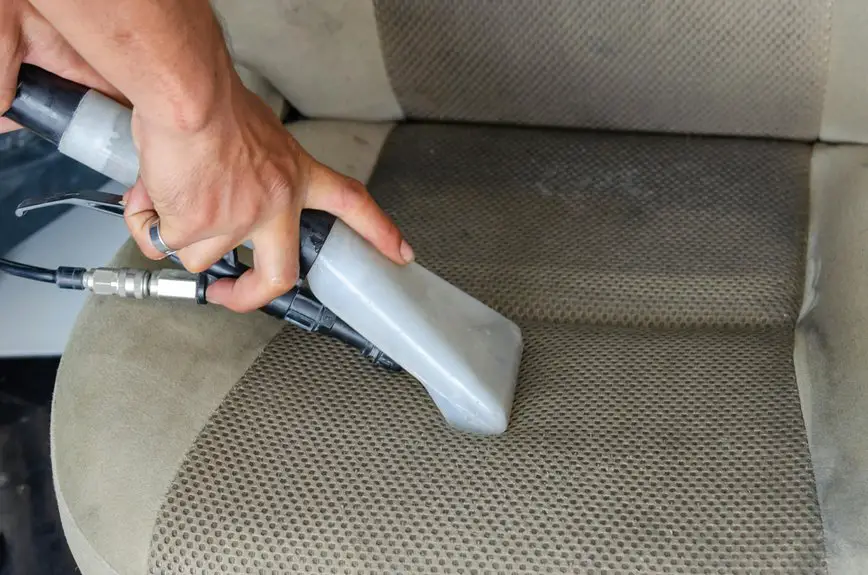To remove water stains from your upholstery, first blot the area gently with a dry cloth—don’t rub. Then, lightly mist a mix of equal parts white vinegar and water, blotting again to lift the stain. Let it air dry completely to prevent damage. To avoid future stains, clean spills immediately, use protective covers, and control indoor humidity. If you want to master cleaning and protecting your furniture, there’s more useful guidance ahead.
Table of Contents
Key Takeaways
- Blot water stains gently with a dry cloth immediately; avoid rubbing to prevent fabric damage.
- Use a 1:1 white vinegar and water solution to lightly mist and lift water stains, testing first in a hidden area.
- Sprinkle baking soda on stubborn stains, let sit 15 minutes, then vacuum to absorb moisture and odors.
- Prevent future stains by using protective covers and cleaning spills immediately while air-drying upholstery thoroughly.
- Control indoor humidity between 30-50% with dehumidifiers and ventilation to reduce moisture buildup and water stains.
Identifying Different Types of Upholstery Fabrics
Before you tackle water stains, you need to identify your upholstery fabric. Different fabrics react differently to water and cleaning solutions, so knowing what you’re dealing with helps you avoid damage.
Check the care label on your furniture for fabric type and cleaning codes like W, S, WS, or X, which indicate suitable cleaners. Natural fibers like cotton and linen absorb water quickly and stain easily, while synthetic fabrics like polyester and nylon resist water better.
Leather and suede require special attention since water can leave marks or cause discoloration. If you can’t find a label, test a hidden area by dabbing a small amount of water and watching for immediate staining or color change.
Identifying your fabric guarantees you pick the right approach to remove water stains safely.
Immediate Steps to Take When Water Stains Occur
When water stains happen, acting quickly can make all the difference in preventing permanent damage. The moment you notice a stain, follow these immediate steps:
- Blot the Area: Use a clean, dry cloth to gently blot the stain. Avoid rubbing, as it can spread the water and push it deeper into the fabric.
- Absorb Excess Moisture: Place a dry towel or paper towels over the area and press down lightly to soak up remaining moisture. Repeat with fresh towels until the spot feels damp, not wet.
- Allow to Air Dry: Keep the upholstery well-ventilated and let it air dry completely. Avoid heat sources, as they can set the stain.
Acting fast helps minimize damage and keeps your upholstery looking fresh.
Using Household Items to Remove Water Stains
Several common household items can effectively tackle water stains on your upholstery without the need for specialized cleaners.
Start by mixing equal parts white vinegar and water in a spray bottle. Lightly mist the stained area, then blot gently with a clean cloth to lift the stain.
Mix equal parts white vinegar and water, mist the stain, then gently blot with a clean cloth to lift it.
You can also use a mild dish soap solution—just add a few drops to warm water, apply sparingly, and blot.
For stubborn stains, sprinkle baking soda over the damp area, let it sit for 15 minutes, then vacuum it up to absorb moisture and odors.
Always test these methods on a hidden spot first to verify they won’t damage your fabric.
With these simple tools, you can manage water stains quickly and effectively right at home.
Specialized Cleaning Products for Upholstery Stains
When household items don’t do the trick, specialized cleaning products can help tackle tough water stains on your upholstery.
You’ll want to choose the right solution for your fabric and follow the application instructions carefully to avoid damage.
Always test a small hidden area first to ascertain safety and maintain your upholstery’s quality.
Types of Cleaning Solutions
You’ll find a variety of specialized cleaning products designed specifically to tackle water stains on upholstery.
Choosing the right type depends on your fabric and the stain’s severity. Here are three common options:
- Enzyme Cleaners – Great for organic stains and breaking down proteins left by water deposits.
- Upholstery Shampoos – Formulated to gently clean delicate fabrics without causing damage.
- Water-Based Cleaners – Ideal for water stains, these solutions dissolve mineral deposits without harsh chemicals.
Each type targets stains differently, so picking one that matches your upholstery fabric guarantees effective stain removal while preserving the material’s integrity.
Always check product labels for fabric compatibility before use, and keep your chosen cleaner handy for quick stain treatments.
Application Techniques
Choosing the right cleaning product is just the first step; applying it correctly makes all the difference in removing water stains from your upholstery. Start by testing the product on a hidden spot to avoid damage. Use a soft cloth or sponge to apply the cleaner gently, working in small sections. Avoid soaking the fabric—too much moisture can worsen stains. Blot, don’t rub, to lift the stain without spreading it. After application, let the area air dry completely before using the furniture again.
| Step | Tool Needed | Tip |
|---|---|---|
| Test Spot | Cloth | Check for colorfastness |
| Apply Cleaner | Sponge | Use gentle, circular motions |
| Drying | Air | Let dry fully, no heat source |
Safety and Fabric Care
Although specialized cleaning products can effectively tackle tough upholstery water stains, you need to prioritize safety and fabric care to avoid damage.
First, always test the product on a hidden area to check for colorfastness.
Second, read and follow the manufacturer’s instructions carefully to prevent fabric deterioration or discoloration.
Third, guarantee good ventilation while cleaning to avoid inhaling harmful fumes.
Using the right product for your upholstery type is essential—some fabrics like silk or velvet require gentler formulas.
Avoid mixing cleaning agents, as this can cause chemical reactions harmful to both you and the fabric.
Techniques for Drying and Restoring Upholstery
Several effective techniques can help you dry and restore upholstery quickly after removing water stains.
First, blot the area gently with a clean, dry towel to absorb excess moisture without rubbing.
Next, use a fan or open windows to increase air circulation and speed up drying. Avoid direct heat like hairdryers, which can damage fabric.
If the fabric looks stiff or discolored after drying, lightly brush it with a soft-bristle brush to lift fibers and restore texture.
For stubborn stiffness, consider using a fabric refresher spray suited for upholstery.
Finally, let the upholstery dry completely before using it again to prevent mildew.
These steps guarantee your furniture looks fresh and extends its lifespan after water stains.
Preventative Measures to Avoid Future Water Stains
To keep your upholstery free from water stains, clean up spills immediately before they set.
Using protective covers can add an extra layer of defense against accidental moisture.
Also, controlling indoor humidity helps prevent dampness that might lead to stains over time.
Immediate Spill Cleanup
When you catch a spill right away, you can stop water stains from setting into your upholstery. Acting quickly prevents moisture from seeping deep into the fabric, making cleanup easier.
Here’s what you should do immediately after a spill:
- Blot, don’t rub: Use a clean, dry cloth to gently blot the spill. Rubbing can push the liquid deeper and damage fibers.
- Apply a mild cleaner: If necessary, dampen a cloth with water mixed with a small amount of upholstery cleaner and blot the area again.
- Dry thoroughly: Use a fan or open windows to air-dry the spot completely. Avoid heat sources that might cause shrinkage.
Use Protective Covers
Cleaning up spills quickly helps reduce water stains, but protecting your upholstery from future damage takes a proactive approach. Using protective covers creates a barrier against moisture, dirt, and everyday wear. You can choose from waterproof slipcovers, fitted fabric covers, or decorative throws to match your style while shielding your furniture. Covers are especially useful in high-traffic areas or homes with kids and pets.
| Cover Type | Pros | Best For |
|---|---|---|
| Waterproof Slipcover | Blocks liquids completely | Families with children |
| Fitted Fabric Cover | Breathable and washable | Everyday use |
| Decorative Throw | Easy to remove and stylish | Light protection and décor |
| Leather Protector | Resists stains and scratches | Leather upholstery |
| Outdoor Covers | Durable and weather-resistant | Patio or sunroom furniture |
Using covers saves cleaning time and extends your upholstery’s life.
Control Indoor Humidity
Humidity plays a big role in causing water stains on your upholstery, so controlling indoor moisture levels can prevent those unsightly marks from forming.
To keep humidity in check, try these steps:
- Use a dehumidifier to maintain indoor humidity between 30-50%. This range minimizes moisture buildup on fabric surfaces.
- Improve ventilation by opening windows or running exhaust fans, especially in damp areas like bathrooms and kitchens.
- Fix leaks and address any water intrusion promptly to stop excess moisture from settling on your furniture.
When to Call Professional Upholstery Cleaners
How do you know if a water stain on your upholstery requires professional attention? If the stain is large, deeply set, or has altered the fabric’s texture, it’s time to call in experts.
Also, if DIY methods haven’t worked or you worry about damaging delicate materials, professionals can handle it safely. Water stains on antique or valuable upholstery especially need expert care.
Additionally, if mold or mildew develops due to moisture, don’t delay contacting a cleaner to prevent health risks.
Professionals use specialized equipment and cleaning solutions that restore your furniture effectively.
Ultimately, when the stain impacts your upholstery’s appearance or comfort beyond your skill level, trusting a professional guarantees the best results and prolongs the life of your furniture.
Frequently Asked Questions
Can Water Stains Damage the Upholstery’S Structural Integrity?
Worried water stains might ruin your upholstery’s structure? While water itself usually won’t cause major damage, repeated exposure can weaken fibers and stitching. So, don’t let stains linger if you want your furniture to last longer.
Are Water Stains Harmful to Pets or Children?
Water stains themselves aren’t harmful to pets or children, but damp upholstery can promote mold or bacteria growth, which might cause allergies or respiratory issues. You should clean and dry stains promptly to keep everyone safe and healthy.
How Long Do Water Stains Take to Set Permanently?
Imagine leaving a spilled drink on your sofa overnight. Water stains can set permanently within a few hours to 24 hours, depending on fabric and moisture. Act quickly to prevent lasting damage to your upholstery.
Can Water Stains Cause Mold Growth on Upholstery?
Yes, water stains can cause mold growth on your upholstery if the fabric stays damp for too long. Mold thrives in moist environments, so you’ll want to dry and clean stains quickly to prevent this.
Is It Safe to Use Steam Cleaners on All Upholstery Fabrics?
You shouldn’t use steam cleaners on all upholstery fabrics because some materials, like silk or velvet, can get damaged. Always check the manufacturer’s label and test a small hidden area before cleaning to avoid ruining your furniture.
- Nonwoven Fabric Production Methods: A Visual Guide - July 11, 2025
- The Ultimate Guide to Nonwoven Polypropylene - July 11, 2025
- What Is the Difference Between a Nonwoven and a Knitted Fabric? - July 11, 2025







